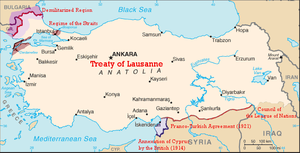| Treaty of Peace and Exchange of War Prisoners with Turkey Signed at Lausanne Accord relatif à la restitution réciproque des internés civils et à l'échange des prisonniers de guerre, signé à Lausanne | |
|---|---|
 Borders of Turkey set by the Treaty of Lausanne. | |
| Signed | 24 July 1923 |
| Location | Lausanne, Switzerland |
| Condition | Following ratification by Turkey and any three of the United Kingdom, France, Italy and Japan, the treaty would come into force for those "high contracting parties" and thereafter for each additional signatory upon deposit of ratification |
| Parties |
|
| Depositary | French Republic |
| Language | English and French |
| Full text | |
The Treaty of Lausanne (French: Traité de Lausanne, Turkish: Lozan Antlaşması) is a peace treaty negotiated during the Lausanne Conference of 1922–1923 and signed in the Palais de Rumine[1][2][3] in Lausanne, Switzerland, on 24 July 1923.[4] The treaty officially resolved the conflict that had initially arisen between the Ottoman Empire and the Allied French Republic, British Empire, Kingdom of Italy, Empire of Japan, Kingdom of Greece, Kingdom of Serbia, and the Kingdom of Romania since the outset of World War I.[5] The original text of the treaty is in English and French.[5] It emerged as a second attempt at peace after the failed and unratified Treaty of Sèvres, which had sought to partition Ottoman territories. The earlier treaty, signed in 1920, was later rejected by the Turkish National Movement which actively opposed its terms. As a result of Greek defeat in the Greco-Turkish War, Turkish forces recaptured İzmir, and the Armistice of Mudanya was signed in October 1922.[6][5] This armistice provided for the exchange of Greek-Turkish populations and allowed unrestricted civilian, non-military passage through the Turkish Straits.
Turkey ratified the treaty on 23 August 1923,[7][8] and all other signatories did so by 16 July 1924.[9]
Additionally, a declaration of amnesty was issued, granting immunity for crimes committed between 1914 and 1922, including the Armenian genocide and Greek genocide. Historian Hans-Lukas Kieser asserts that "Lausanne tacitly endorsed comprehensive policies of expulsion and extermination of hetero-ethnic and hetero-religious groups".[10]
- ^ Archives de la Ville de Lausanne (consulté le 22.07.23)
- ^ "Palais de Rumine". www.lonelyplanet.com. Archived from the original on 14 September 2018. Retrieved 6 September 2018.
- ^ "Palais de Rumine & Musée cantonal des Beaux-Arts". MySwitzerland.com. Retrieved 6 September 2018.
- ^ Xypolia, Ilia (2021). "Imperial Bending of Rules: The British Empire, the Treaty of Lausanne, and Cypriot Immigration to Turkey". Diplomacy & Statecraft. 32 (4): 674–691. doi:10.1080/09592296.2021.1996711. hdl:2164/18252. S2CID 246234931. Archived from the original on 14 January 2023. Retrieved 19 April 2022.
- ^ a b c Treaty of Peace with Turkey signed at Lausanne, Lausanne, Switzerland, 24 July 1923, archived from the original on 12 January 2013, retrieved 28 November 2012
{{citation}}: CS1 maint: location missing publisher (link) - ^ "Armistice of Mudanya". Archived from the original on 2 February 2021. Retrieved 17 November 2021.
- ^ Martin Lawrence (1924). Treaties of Peace, 1919–1923. Vol. I. Carnegie Endowment for International Peace. p. lxxvii.
- ^ "Official Journal, October 1924". League of Nations Official Journal. 4: 1292. October 1924.
- ^ Hansard, House of Commons Archived 18 October 2017 at the Wayback Machine, 16 July 1924.
- ^ Cite error: The named reference
Kieserwas invoked but never defined (see the help page).